Below is a summary of a seed trial report ECHO received in 2013 from Peace Corps Volunteer Chris Peterson, working in Uganda (Nalugala, Wakiso District). Sharing the results of Peterson’s efforts serves as an example of what to expect from a seed trial. Trying new crops can be very challenging, and likely not all crops will be successful. Nonetheless, seed trials are valuable, low-risk methods to inform agricultural development plans.
Overview
Many Ugandan farmers do not work the land during the dry season due to a common perception that nothing can be grown during that time. However, crops like sorghum and millet are able to tolerate dry conditions. Chris Peterson set out to develop a “dry season” demonstration garden at the Bega kwa Bega Uganda Orphans (BKB) organic demonstration farm, using seed of drought-tolerant plants from ECHO’s Global Seed Bank. He hoped that lessons learned about extending farm productivity would help ensure local food security. The trial also offered a chance to demonstrate inexpensive water conservation techniques.
Site description

Figure 5. Part of the organic demonstration farm at Bega kwa Bega. Source: Chris Peterson
The BKB farm (Figure 5) is situated approximately 1177 m (3850 feet) above sea level, on Lake Victoria between Entebbe and Kampala, Uganda. The plot grade is nearly level to slightly sloping. The soil is high in clay, prone to stones, and dusty when dry. The site performed poorly in past years. A previously planted citrus grove did not do very well, even when intercropped with cabbage, beans, or eggplant.
According to Peterson, “Numerous old termite mounds (not breaking the current surface) exist within the plot. A perception exists that termite mound soil is poor, because mound soil is difficult to dig even when wet, and impossible to dig when dry. However, mound soil is rich in nutrients (from deep soil nutrients being brought to the surface by termite activity) and organic matter (from termite feces and saliva) (Peterson, 2010) and is quite beneficial to plants when the hard clumps are allowed to weather and crumble. Farmers should be encouraged to chip away at old termite mounds and disperse the soil within their farms.”
At BKB, and more commonly in the region, farmers and farm workers removed crop residue from the fields due to pest problems. However, that practice resulted in loss of organic matter and nutrients from the plot.
Seeds
Peterson obtained ten sample seed packets of drought-tolerant plants from ECHO’s Global Seed Bank. Table 1 lists the seeds by name, date of planting, germination date, germination success, plant growth, and harvest success.
Peterson planted a high proportion of bean species in the trial, because the local community already viewed beans as a valuable crop. He shared, “It should be readily adopted if it grows well.” He continued, “I had initial concerns regarding jicama, as the beans and pods are poisonous and the community is likely to expect to eat them rather than their tubers. I have a similar concern with egusi melon, although watermelons are common: the community is going to expect to eat the melon (which is not edible) rather than go through the work of dehulling and processing the melon seeds.”
| Table 1. Seeds from ECHO’s Global Seed Bank, planted in 2013 at Bega kwa Bega organic demonstration farm. | ||||||||
| Common Name | Scientific Name | Planting Date | # Planted | Date Germinated | Germination | Growth | Harvest | Worth growing again? |
| Chickpea/Garbanzo | Cicer arietinum | 2/20 | 23 | 2/26 | Excellent | Good | Failed | Yes, with attention paid to pest control |
| Jicama/ Yam Bean | Pachyrhizus erosus | 2/25 | 28 | 3/15 | Good | Fair | Good | No, not likely to be popular |
| Dragon’s Claw Millet | Eleusine coracana | 2/26 | Broadcast | 3/8 | Excellent | Excellent | Excellent | Yes |
| Cowpea | Vigna unguiculata ‘Bettergro Blackeye Pea' | 2/20 | 48 | 2/24 | Excellent | Good | Failed | Yes, if proper attention paid to crop spacing and disease control |
| Mung bean/ Green gram | Vigna radiata | 2/19 | 67 | 2/24 | Excellent | Excellent | Excellent | Yes |
| Okra | Abelmoschus esculentus | 2/19 | 50 | 2/24 | Excellent | Excellent | Excellent | Yes |
| Lablab | Lablab purpureus 'White' | 2/25 | 30 | 3/5 | Excellent | Excellent | Poor | Yes, if proper attention paid to spacing |
| Egusi | Citrullus lanatus ssp. colocynthoid | 2/20 | 12 | 2/26 | Poor | Poor | Failed | No |
| Tarwi | Lupinus mutabilis | 2/20 | 24 | 2/27 | Poor | Poor | Failed | No |
| Sorghum | Sorghum bicolor ‘Striga Resistant’ | 2/20 | 110 | 2/26 | Excellent | Excellent | Excellent | Yes |
Planting
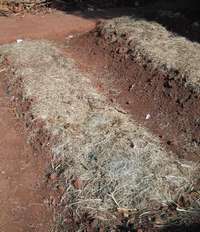
Figure 6. Raised beds covered with mulch. Source: Chris Peterson
Peterson planted each species on both a raised bed (Figure 6) and non-raised bed. He reasoned that, while raised beds were familiar to the local community, flat ground would hold water better. He worked the soil with a modified “double dig” approach, where the top 12 inches (30 cm) of the soil is removed in a two-foot (60 cm) wide trench, and then mixed with animal manure (cow, goat, or chicken) as it is replaced.
Initial Irrigation
After planting, each bed was watered enough to wet the soil beyond the seeds. Then, each bed was watered once per day for the first week and once every two days in the second week. After that, plants were watered as needed (about once every three or four days, since the mulch mitigated water loss).
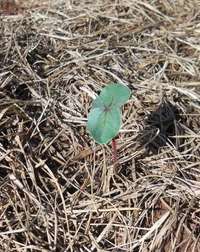
Figure 7. Okra seedling emerging from fine grass mulch. Source: Chris Peterson.
The plants under the fine grass mulch (Figure 7) had higher and faster germination rates and fewer weeds than plants under coarse mulch. Overall survival of seedlings was sporadic, with high plant mortality in some areas but not others. Peterson commented, “The coarse mulch may have attracted termites that ate the seeds or the sprouts. Another hypothesis is [that] the presence of phytotoxins from coarse mulch, especially mango leaves, [inhibited germination and/or plant growth].”
Peterson shared, “The rains returned approximately one month after planting, which illustrates one of the limitations of a dry season garden. It might take longer for the plants to mature than the dry season lasts. In that case, land devoted to dry season crops cannot be used for other things during part or even all of the wet season. Depending on productivity of the crops, the farmer might be better served by waiting out the dry season and planting more productive crops when the rains return. This will, of course, depend on the specific locale and the length of the dry season.”
Results
Most plants from the trial were mature and harvested by the end of the rainy season in May. By this time, Peterson had an idea of what worked and what did not in his context. Sometimes even when plants grew and produced well, they were not “successful” for cultural reasons.
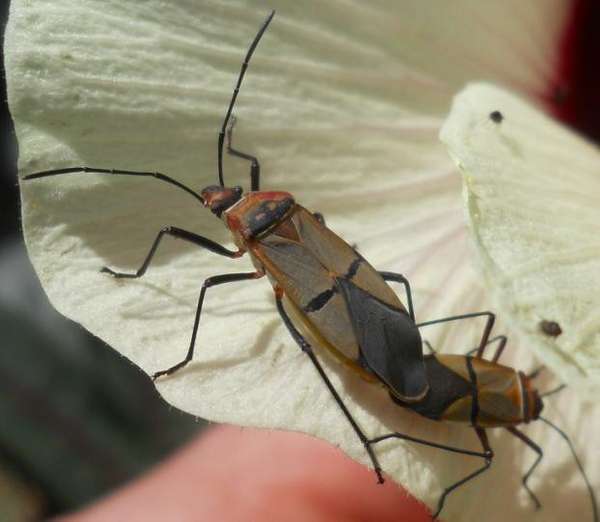
Figure 8. Cotton stainers on okra. Source: Chris Peterson.
Okra: Fifty seeds were planted, and ten plants survived. The okra plants sustained some minor damage from insects. Cotton stainers (which feed on seeds inside the pods; Figure 8) appeared in large numbers about halfway through the plants’ lives. A few curled pods were found to be infested by burrowing insect larvae (perhaps let in through cotton stainer feeding). Nevertheless, over 200 pods were harvested. The final pods were allowed to mature and produce seed; they yielded enough to mostly fill a small glass jar. Peterson wrote, “The farm staff responded well to the crop, and have begun growing okra on the farm and consuming it cut up into pots of beans. Many of the local residents have expressed interest in growing okra and in its preparation. The farm will begin selling produce in the coming months, and we have confidence that okra pods and seeds will be popular items.”
Mung beans: Sixty-seven mung beans seeds were planted, and nearly all germinated. Plants produced 20 to 30 pods per plant, and each pod contained at least 10 seeds. The pods matured about two months after planting and dried down well. The mung beans finished producing new pods after about three months, and the final pods matured a few weeks later. Peterson commented that maybe the plants could be replaced with something else once the initial crop was harvested. He also shared, “A cultural barrier exists to their use: ‘I see the Indians eating them’ is a common comment. Indians are not actively discriminated against here, but Indian food is ‘not Ugandan.’…This surprised me, because the beans are small and therefore will require little time or fuel to cook, and the readiness with which the farm staff adopted okra led me to believe there would be more enthusiasm for mung beans.”
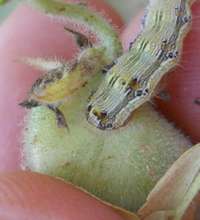
Figure 9. Caterpillar destroying chickpea pod. Source: Chris Peterson.
Tarwi: All tarwi plants died within three months of planting. They produced neither pods nor seed.
Chickpeas: After three months, the chickpea plants had produced many pods. However, caterpillars ate the pods (Figure 9) and mealy bugs attacked the roots. Only about a dozen seeds were collected (harvested early so insects would not get them). Peterson theorized that chickpeas might grow better in cooler areas less favorable to insect pests.
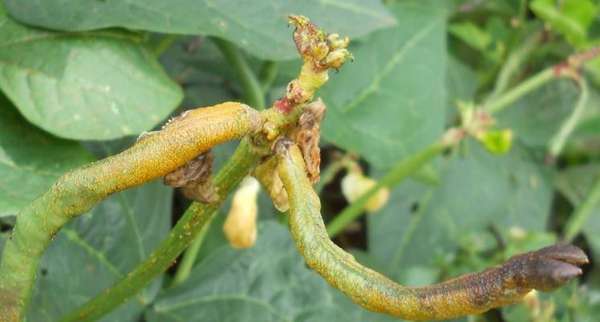
Figure 10. Disease-infested cowpea pods. Source: Chris Peterson.
Cowpeas: The cowpeas grew a lot, but produced few pods. Some plants succumbed to a fungal plant disease (Figure 10; about one plant per week), with an outbreak after the rains returned. Peterson commented, “Substantial insect feeding along the [vines] was observed, but the plants appeared to tolerate the damage. It appears there were other diseases present, as the pods were irregular in shape and seemed to contain few seeds. This might have been due to a failure of pollination. Because cowpea was reported to tolerate some shade, I planted them in the shadiest part of the garden. Lack of direct sunlight might have allowed a moist microclimate to develop, leading to a disease outbreak. Wider spacing at the next planting might alleviate these problems. Birds or squirrels (unknown culprit) destroyed the few healthy pods I had been watching. No beans were collected, which was surprising because cowpeas are known in this part of Africa and can be bought in the local markets. Therefore, it seems my agronomic practices (planting too close together, planting in the shade) are responsible for the failure of this crop.”
Egusi: Peterson commented, “The vines succumbed to a plant disease between two and three months after planting. The seeds in the salvaged fruits had been eaten by beetles or dried to nothing. The seeds were not mature by the time the plants died. No seeds were collected.”
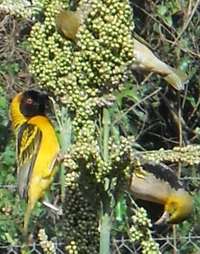
Figure 11. Birds eating sorghum seed from the stalks. Source: Chris Peterson.
Millet: The millet plants matured about four months after planting. They had no significant pests (other than goats occasionally nibbling the tops of the plants) and produced around 2 L of millet seed. According to Peterson, “Millet is a popular staple crop in certain parts of Uganda, used to make a starchy food item called in various places tapa, kalo, or millet bread (“bread” is a misnomer; the product is not leavened or baked, but instead the flour is boiled in water into a blob of a consistency between mashed potatoes and bread dough, and is eaten hot with a sauce). Millet brews and breakfast porridges similar to runny oatmeal are also common.”
Sorghum: Peterson shared that the sorghum plants grew well and were ready to harvest after four or five months. He said that the plants produced very well but, “Once the seeds matured, weavers and lovebirds came to eat them [Figure 11], and foil scarecrows did nothing to keep the birds away.” Peterson added, “Different types of sorghum are used throughout Uganda for different purposes: porridge, for animal feed, and for a fermented local brew. Sorghum is used in some commercially produced brands of beer. I had hoped to leave the old stalks in place as poles for beans, but termites destroyed the stalks before the beans could be planted.”
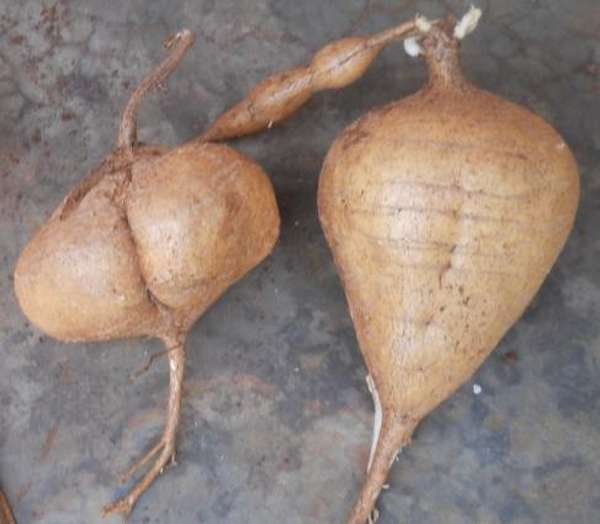
Figure 12. Jicama tubers. Source: Chris Peterson.
Jicama: Jicama plants grew slowly from seed, but were relatively unscathed from insects and diseases. It was one of the last crops to mature; vines died down five months after planting. The plants yielded few seeds and the tubers varied in size from 1 to 4 inches (2.5 to 10 cm) in diameter (Figure 12). Peterson wrote, “I left some tubers in the ground to see if vegetative growth would be better when the tubers resumed growth. The sprouting tops of harvested tubers were planted to observe how well they grew, but that effort has just begun. Jicama proved to be unpalatable to the Ugandans, and marginally palatable to me. Unless the tubers produce many more and larger tubers than the seeds did, I don’t think it will be able to compete with Irish potatoes, yams, or cassava as a tuber crop. In addition, jicama is often eaten raw (it’s said they get tough when cooked) and Ugandans are hesitant to eat any raw vegetable. I encountered the same barrier when growing radishes and lettuce. The Ugandans I talked to insist all vegetables must be cooked. Perhaps this is good and reflects an awareness of the danger of contracting worms or other parasites from soil.”

Figure 13. The lablab plants grew vigorously but produced few seeds. Source: Chris Peterson.
White Lablab: Peterson wrote, “The white lablab proved to be an aggressive climber, three-foot stakes not being tall enough to contain the plants. The plants grew all over the place, but relatively few seeds were produced [Figure 13]. The plants are still actively growing five months later, but by now I am confident I know what to expect from this plant. Although the beans are reported to be edible, not many produced and [for me] the true value in this crop is (as we already know) its use as a livestock feed. Plants grown singly rather than in rows produced more seeds although vegetative growth was about the same. Pods sometimes appeared to be infested with a black-colored fungus, and the seeds within were discolored or wrinkled. It is unclear at this point if such seeds will germinate well. The few stored seeds were quickly infested with stored grain beetles, but this might have been prevented by better storage. In subsequent plantings, I hope to note the effects of regular slashing on regrowth. If the plant regrows well, and since it survived the second (and more severe) dry season, it could greatly improve the farm’s supply of cattle and pig feed.”
Longer-term reflections
In the fall of 2019, six years after the initial seed trial report was written, Peterson shared some longer-term reflections. He commented, “The main success [of the seed trial] was convincing the farm staff of the value of mulching. When they saw the germination results they were [convinced] and mulched their planting beds from then on; seeing that only a thin layer was necessary made a difference.”
Introducing new and unfamiliar foods proved challenging. “Okra…grew well and [farm staff] enjoyed it when I cooked it for them, [but] they didn't know what to do with it when they grew it themselves. I shared some saved seeds, only to be presented several months later with wooden, shattered okra pods and being asked how they were supposed to be cooked. The idea of harvesting a non-mature product was not familiar, and they struggled with knowing when they were supposed to harvest.” Lablab was familiar, but not as a human food. “Because lablab is only grown for animal forage [here], they weren't interested in the beans, probably because of the work required in preparation and the ready availability of other beans requiring less effort to prepare.”
Overall, Peterson concluded, “the idea of dry-season gardening did not take off because this ties up land that would be more productive once the rains returned. With two rainy seasons per year in that part of Uganda, there was little reason to invest the real estate in [attempting to produce] a meager supplemental crop in the relatively short dry seasons. The approach might be more successful in areas with longer dry seasons.”
Reference
Peterson, C. 2010. Review of termite forest ecology and opportunities to investigate the relationship of termites to fire. Sociobiology 56: 313–352.
Cite as:
ECHO Staff 2020. How Seeds from ECHO Grew in a Dry-Season Garden in Uganda. ECHO Development Notes no. 149